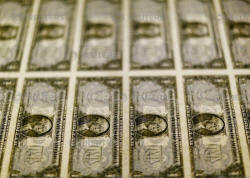Struggling hedge funds cling to dollar, U.S. yield curve
bets: McGeever
 Send a link to a friend
Send a link to a friend
 [December 11, 2018]
By Jamie McGeever [December 11, 2018]
By Jamie McGeever
LONDON (Reuters) - Hedge funds have
struggled badly in 2018, but would be faring far worse were they not on
the right side of two of the most reliable trades of the year: a
flattening U.S. yield curve and a stronger dollar.
Both trends remain in place, and as the latest data show, speculators
look like holding onto them for the rest of the year.
Funds increased their net long dollar position against a range of
developed and emerging-market currencies by nearly $2 billion to $32.09
billion in the week to Dec. 4, according to Commodity Futures Trading
Commission figures. That's the biggest cumulative bet on a rising dollar
in three years.
They also increased their net short position in two-year Treasuries by
the second largest amount this year and upped their short position in
10-year bonds by only a fraction, effectively a bet that the gap between
two- and 10-year yields will narrow.
The dollar is up 5 percent so far this year -- up 10 percent from the
low in February -- while the 2s/10s yield curve is the flattest in over
a decade, coming within 10 basis points of recession-warning inversion
last week.

(For a graphic on 'U.S. yield curve' click https://tmsnrt.rs/2zVNhqO)
That may suggest these trades are stretched and due for a bout of
year-end profit-taking. Perhaps, but they have been among the few shafts
of light in a gloomy year for the hedge fund community.
Barclayhedge's main hedge fund index is down 2.48 percent so far this
year and its macro fund index is down 4.06 percent, while the fixed
income arbitrage index is up 2.33 percent. These are the poorest annual
performances for years.
Eurekahedge figures paint an even bleaker picture. Its main hedge fund
index is down 2.40 percent so far in 2018, the worst year in a decade
and on course for only the third annual loss since 2000.
The CTAs/Managed Futures index is down 4.21 percent and the Macro Index
is down 2.55 percent year to date, both heading for their only annual
loss since 2000. Even the Fixed Income index, up 0.37 percent, is having
its worst year since 2008.
And that's despite speculators, by and large, being on the right side of
the dollar and yield curve trades, central to which has been how much
further the Federal Reserve plans to tighten U.S. monetary policy.
[to top of second column] |

United States one dollar bills are seen on a light table at the
Bureau of Engraving and Printing in Washington November 14, 2014.
REUTERS/Gary Cameron/File Photo

Up until a few weeks ago, the Fed seemed committed to raising rates at least
three times next year. Growth is steady, unemployment is at a 50-year low, and
most of the incoming economic data is still looking fairly solid.
Yet markets didn't quite buy into that glass-half-full view. Hedge funds may
have extended their short two-year bonds position -- it's now 361,560 contracts,
within 1,000 of the record short from last month -- but have dramatically cut
back their short position in longer-dated bonds.
(For a graphic on 'CFTC 2-year Treasuries positions' click https://tmsnrt.rs/2SHoQ7I)
The result has been a collective bet that the yield curve will flatten, which is
exactly what has unfolded. Parts of the curve at the short end have even
inverted already, such as the 3s/5s curve.
If curve flattener trades are to be unwound, it will most likely be led by the
short end. Funds' net short position in 10-year Treasury futures is a sizeable
293,186 contracts, but it's worth bearing in mind that it was more than 750,000
as recently as September.
A year ago, funds were actually long 10-year bonds, so positioning in this part
of the curve isn't extreme.
(For a graphic on 'CFTC 10-year Treasuries positions' click https://tmsnrt.rs/2zQeBa4)
Hedge funds' dollar bets look more stretched, especially now that the Fed's path
next year is less clear-cut. Officials from Chair Jerome Powell down now suggest
rates may be close to "neutral", and money markets no longer fully price even
one quarter-point rate hike in 2019.
Yet even if the Fed does take its foot off the gas next year, the likelihood of
euro zone, UK, or Japanese policy being tightened to any significant degree next
year remains small.
The dollar could continue to enjoy its yield advantage for a while yet.
(The opinions expressed here are those of the author, a columnist for Reuters)
(By Jamie McGeever, editing by Larry King)
[© 2018 Thomson Reuters. All rights
reserved.] Copyright 2018 Reuters. All rights reserved. This material may not be published,
broadcast, rewritten or redistributed.
Thompson Reuters is solely responsible for this content. |